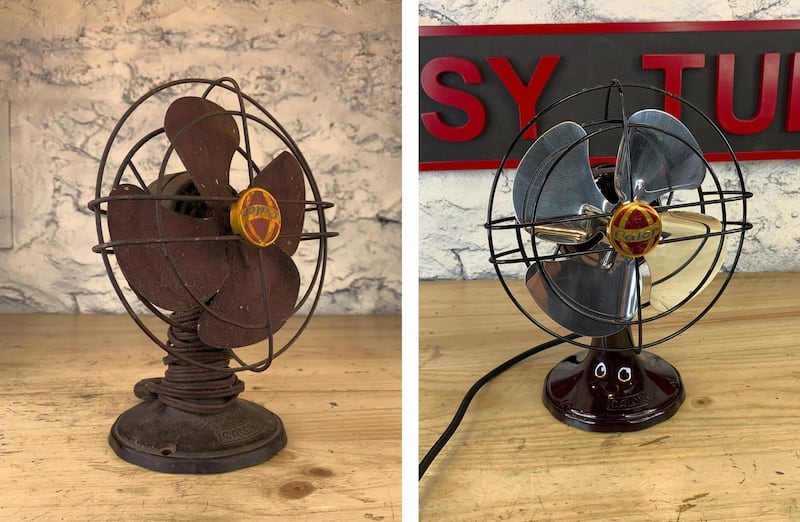The success of YouTube has completely democratised video entertainment. Media companies no longer decide what we ought to be watching; we can decide, and if what we want isn't being made, we can simply make it ourselves.
In the 14 years since the video-sharing site launched, it has seen the rise of genres that would never have been commissioned by television companies, and whose appeal has been completely unexpected. Gamers showing off their skills on PS4, ridiculously detailed food reviews, ranting conspiracy theories and gently whispered lullabies have all hit the big time, but in the past few months, a new trend has emerged that features no big personalities, big reveals or shock tactics. It's simply people taking objects afflicted with rust, dust and grime and carefully restoring them.
The rise of restoration
Since last summer, the top five restoration channels have accumulated more than one billion views between them, and their popularity has inspired many others to start a hobby that's wholesome, calming and good for the planet. "Ever since I was young I've always wanted to take things apart and see how they work," says Steve Ablitt, creator of the Restore It channel. "I remember my mother would always tell me to stop, saying leave it alone, that I'd ruin it. But I've always been drawn to hands-on stuff."
Ablitt's videos, and indeed those of the whole genre, follow a very similar pattern: they begin with shots of the decaying object from every angle, whether it's a vintage table fan, a water-damaged clock, a broken drill or a rusty corn milling machine. It's carefully taken to bits, with every nut and bolt laid out for inspection. Then each piece is cleaned, polished – or, as a very last resort, replaced. It's then painted, reassembled and demonstrated to be working perfectly. And audiences have gone mad for it, subscribing in their millions. "All of these videos are beautiful works of mechanical art," says one enthusiast. "It inspires me to have a go."
Copycat channels are emerging all the time. “So many people are doing their own restorations, now,” says the anonymous creator of the TysyTube channel, who we’ll simply call Tysy. “It’s growing so fast.”
Neither Ablitt nor Tysy have any special training. They're just enthusiastic amateurs with a perfectionist streak. "I'm completely self-taught from the internet," says Ablitt. "I've learnt by trial and error and there's been a lot of editing. I cut out a lot of the mistakes and the misery, because they're not enjoyable to watch."
The deeply satisfying transformation of a lump of rust into a beautiful vintage object offers a persuasive reminder that things can be repaired and regenerated, and all it requires is some hard work. "I spend at least a week on each of them, if not two or three," says Ablitt.
The appeal of watching something being restored
The genre shines a spotlight on the wastefulness of modern economies, where throwing broken things away is second nature. It also has parallels with the global rise of Repair Cafes, where teams of volunteers battle disposable culture by helping visitors to repair broken items. In today's cookie-cutter world of manufacturing, the objects restored by these channels feel quirky, elegant and unique – and many of the results are achieved very cheaply. "You need a few tools, but my last project cost me maybe €30 (Dh124)? It's really not that much," says Tysy.
The appeal of these videos isn't just down to their ecological credentials. An unattractive, unused and unloved object gaining a new lease of life (as Tysy's channel slogan says, "Make something new from something old") is a compelling and delightful narrative. It has some similarities to the genre of so-called autonomous sensory meridian response, or ASMR videos, where the viewer's desire for calming, unthreatening entertainment is catered for with slow-paced make-up tutorials, towel-folding, shirt-ironing and gentle words of reassurance. "Someone told me recently that they'd watched my video of restoring a wiring loom in a car and that they'd found themselves in a sort of a tranquil state," says Albitt.
An anonymous nature
The anonymity of the genre contributes to its restful nature. Unusually for YouTube, very few (if any) words are spoken, and very few (if any) faces are seen. Just shots of hands doing the work, and the occasional caption where necessary. “I love to watch work being done without a personality fronting it and without any opinions being expressed,” says Ablitt. “Then I don’t have to think whether I like that person or not.”
Indeed, the restorers' shunning of the limelight is charming in itself. "It might be because we're afraid to speak to the camera," says Tysy. "I certainly don't like it. I could show my face, but then maybe people wouldn't want to watch."
YouTube viewers are known for their blunt criticism, and while the restorers' anonymity curbs some of the rudeness in the comments section, it's impossible to become a YouTube sensation and to completely escape grievances. Viewers complain that these antique pieces are being deprived of their age, that they should be allowed to decay gracefully – and, more commonly, that restorations are being done "wrong" and aren't sufficiently authentic. "I was upset by those comments at the start," says Tysy. "But if you pay attention to the bad ones, you'll just end up stopping doing something you enjoy."
These works of "mechanical art" are piling up in sheds all over the world. Between TysyTube, Restore It and other leading channels – Gear Show, My Mechanics, Hand Tool Rescue and Really Random Channel – more than 100 objects have been restored in the past six months and the thousands of hours of work has prompted a close attachment with their creators. "Each of the pieces has their own story," says Albitt. "I spend so long on them that it's hard to get rid of them."
Tysy feels similarly. "For now, I keep all the objects, but I'm running out of space. Maybe I'll sell them on eBay one day, but I don't know if people would want to buy them?"
If viewers and subscriber numbers are anything to go by, there’d be no shortage of enthusiastic bidders wanting to secure a memento of their favourite video.






